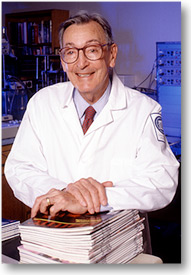
Research led by Furchgott and colleagues Louis Ignarro and Ferid Murad showed that nitric oxide -- known primarily as an air pollutant from cigarettes and car engines that contributes to smog -- plays a vital role in the human cardiovascular system and regulating blood pressure and circulation.
The three researchers earned the Nobel prize for physiology in 1998, with the Swedish academy stressing it was the first time scientists proved the critical effects of a gas on biochemical functions in the human body.
The discovery of the effect of nitric oxide, a colorless and odorless gas, on the relaxation of blood vessels marked a key step in laboratory company Pfizer's development of the erectile dysfunction drug sildenafil, which it markets under the name Viagra.
The little blue pill was approved by the US Food and Drug Administration in 1998 as a treatment for erectile dysfunction and became enormously popular, bursting perceived social taboos of treating such a condition, with some 35 million men worldwide using the drug.
Furchgott was born in Charleston, South Carolina on June 4, 1916, and as a youth developed a passion for the natural sciences.
He graduated from the University of North Carolina with a chemistry degree and earned a doctorate in biochemistry from Northwestern University in 1940.
He worked for years at the State University of New York, among other colleges, and continued doing research and teaching into his 80s despite a partial retirement.
In 1978, he accidentally discovered an element in endothelial cells that relaxes blood vessels, describing it as endothelium-derived relaxing factor, or EDRF. Eight years later, he figured out that EDRF was in fact nitric oxide.
During his Nobel acceptance speech, Furchgott noted the irony that the prize's namesake Alfred Nobel, celebrated for his work with nitroglycerine and dynamite, had suffered from angina, the insufficient flow of oxygenated blood to the heart for which he was prescribed nitrogylcerine, itself a known blood vessel dilator.
Furchgott pointed to the "seemingly fated progression" from the creation of dynamite to the laureate's discovery of the molecule in nitrogylcerin responsible for the dilation of blood vessels that would help people like Nobel.
-------------------------------------------------------------------------------------------------------------
The three researchers earned the Nobel prize for physiology in 1998, with the Swedish academy stressing it was the first time scientists proved the critical effects of a gas on biochemical functions in the human body.
The discovery of the effect of nitric oxide, a colorless and odorless gas, on the relaxation of blood vessels marked a key step in laboratory company Pfizer's development of the erectile dysfunction drug sildenafil, which it markets under the name Viagra.
The little blue pill was approved by the US Food and Drug Administration in 1998 as a treatment for erectile dysfunction and became enormously popular, bursting perceived social taboos of treating such a condition, with some 35 million men worldwide using the drug.
Furchgott was born in Charleston, South Carolina on June 4, 1916, and as a youth developed a passion for the natural sciences.
He graduated from the University of North Carolina with a chemistry degree and earned a doctorate in biochemistry from Northwestern University in 1940.
He worked for years at the State University of New York, among other colleges, and continued doing research and teaching into his 80s despite a partial retirement.
In 1978, he accidentally discovered an element in endothelial cells that relaxes blood vessels, describing it as endothelium-derived relaxing factor, or EDRF. Eight years later, he figured out that EDRF was in fact nitric oxide.
During his Nobel acceptance speech, Furchgott noted the irony that the prize's namesake Alfred Nobel, celebrated for his work with nitroglycerine and dynamite, had suffered from angina, the insufficient flow of oxygenated blood to the heart for which he was prescribed nitrogylcerine, itself a known blood vessel dilator.
Furchgott pointed to the "seemingly fated progression" from the creation of dynamite to the laureate's discovery of the molecule in nitrogylcerin responsible for the dilation of blood vessels that would help people like Nobel.
-------------------------------------------------------------------------------------------------------------









 Home
Home Politics
Politics









